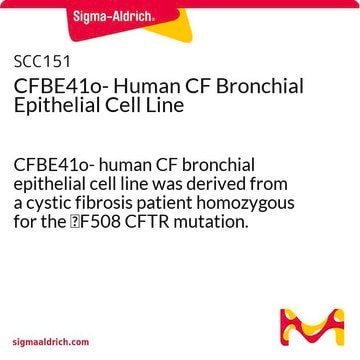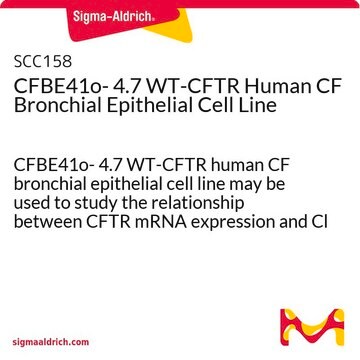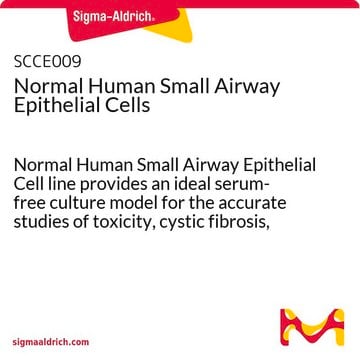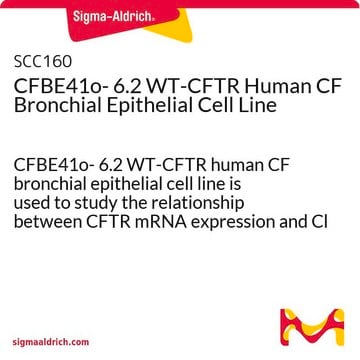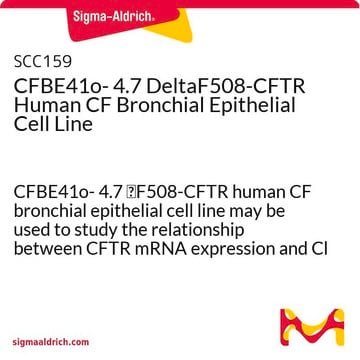SCC162
CFTE29o- Human Cystic Fibrosis Tracheal Epithelial Cell Line
Human
Sinónimos:
CFTE29o, CFTE-29o-
About This Item
Productos recomendados
product name
CFTE29o- Human Cystic Fibrosis Tracheal Epithelial Cell Line, CFTE29o- human cystic fibrosis tracheal epithelial cell line is a useful model for cystic fibrosis research and for studying chloride ion transport and ion transport in human airways.
biological source
human
technique(s)
cell based assay: suitable
cell culture | mammalian: suitable
shipped in
ambient
Categorías relacionadas
General description
CFTE29o- is a human CF tracheal epithelial cell line, derived from a 21-yr old male CF patient homozygous for the ΔF508 CFTR mutation and immortalized with the origin-of-replication defective SV40 plasmid (pSVori-) . The cell line express keratin, indicating an epithelial cell origin, along with a calcium-dependent cell adhesion protein, cellCAM 120/80 , and ZO-1 indicating the ability to form tight junctions. CFTE29o- displays ion transport properties characteristic of cystic fibrosis such as defective cAMP-dependent chloride transport. Upon treatment with the calcium ionophore, ionomycin, CFTE29o- secretes chloride, albeit at reduced levels relative to normal cells. The cells express CFTR mRNA, and small amounts of CFTR protein as assessed by Western blot hybridization . Karyotype analysis indicates that 70% of the cells contain two copies of chromosome 7 .
CFTE29o- is a useful model for cystic fibrosis and for studying chloride ion transport and ion transport in human airways. The cells are useful for testing candidate chemotherapeutic drugs for their potential as treatments for ameliorating CF pathologies.
Cell Line Description
Application
Quality
• Cells are tested by PCR and are negative for HPV-16, HPV-18, Hepatitis A, C, and HIV-1 & 2 viruses as assessed by a Human Essential CLEAR panel by Charles River Animal Diagnostic Services.
• Cells are negative for mycoplasma contamination.
• Each lot of cells is genotyped by STR analysis to verify the unique identity of the cell line.
Storage and Stability
Disclaimer
Unless otherwise stated in our catalog or other company documentation accompanying the product(s), our products are intended for research use only and are not to be used for any other purpose, which includes but is not limited to, unauthorized commercial uses, in vitro diagnostic uses, ex vivo or in vivo therapeutic uses or any type of consumption or application to humans or animals.
Storage Class
10 - Combustible liquids
wgk_germany
WGK 1
flash_point_f
Not applicable
flash_point_c
Not applicable
Certificados de análisis (COA)
Busque Certificados de análisis (COA) introduciendo el número de lote del producto. Los números de lote se encuentran en la etiqueta del producto después de las palabras «Lot» o «Batch»
¿Ya tiene este producto?
Encuentre la documentación para los productos que ha comprado recientemente en la Biblioteca de documentos.
Artículos
16HBE14o- human bronchial epithelial cells used to model respiratory epithelium for the research of cystic fibrosis, viral pulmonary pathology (SARS-CoV), asthma, COPD, effects of smoking and air pollution. See over 5k publications.
Nuestro equipo de científicos tiene experiencia en todas las áreas de investigación: Ciencias de la vida, Ciencia de los materiales, Síntesis química, Cromatografía, Analítica y muchas otras.
Póngase en contacto con el Servicio técnico